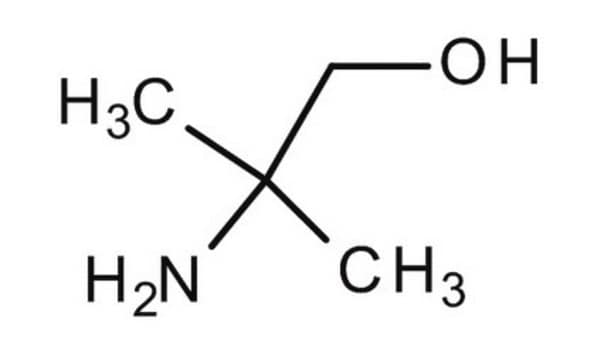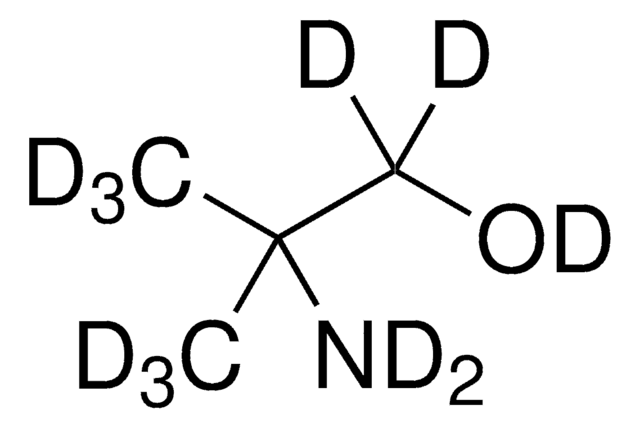A9199
2-Amino-2-methyl-1-propanol
BioXtra, ≥95%
Synonym(s):
β-Aminoisobutyl alcohol, AMP
About This Item
Recommended Products
vapor density
3 (vs air)
Quality Level
vapor pressure
<1 mmHg ( 25 °C)
product line
BioXtra
Assay
≥95%
form
liquid
impurities
≤0.005% Phosphorus (P)
≤0.1% Insoluble matter
ign. residue
≤0.1%
refractive index
n20/D 1.4455 (lit.)
pH
11.0-12 (25 °C, 8.9 g/L)
useful pH range
9.0-10.5
pKa (25 °C)
9.7
bp
165 °C (lit.)
mp
24-28 °C (lit.)
solubility
H2O: 0.5 M at 20 °C, clear, colorless
density
0.934 g/mL at 25 °C (lit.)
anion traces
chloride (Cl-): ≤0.05%
sulfate (SO42-): ≤0.05%
cation traces
Al: ≤0.0005%
Ca: ≤0.0005%
Cu: ≤0.0005%
Fe: ≤0.0005%
K: ≤0.005%
Mg: ≤0.0005%
NH4+: ≤0.05%
Na: ≤0.005%
Pb: ≤0.001%
Zn: ≤0.0005%
SMILES string
CC(C)(N)CO
InChI
1S/C4H11NO/c1-4(2,5)3-6/h6H,3,5H2,1-2H3
InChI key
CBTVGIZVANVGBH-UHFFFAOYSA-N
Looking for similar products? Visit Product Comparison Guide
Application
Biochem/physiol Actions
Signal Word
Danger
Hazard Statements
Precautionary Statements
Hazard Classifications
Aquatic Chronic 3 - Eye Dam. 1 - Skin Irrit. 2
Storage Class Code
11 - Combustible Solids
WGK
WGK 1
Flash Point(F)
179.8 °F - closed cup
Flash Point(C)
82.1 °C - closed cup
Personal Protective Equipment
Regulatory Listings
Regulatory Listings are mainly provided for chemical products. Only limited information can be provided here for non-chemical products. No entry means none of the components are listed. It is the user’s obligation to ensure the safe and legal use of the product.
FSL
Group 4: Flammable liquids
Type 2 petroleums
Hazardous rank III
Water soluble liquid
ISHL Indicated Name
Substances Subject to be Indicated Names
ISHL Notified Names
Substances Subject to be Notified Names
JAN Code
A9199-250ML:
A9199-BULK:
A9199-VAR:
A9199-100ML:
A9199-500ML:
Choose from one of the most recent versions:
Already Own This Product?
Find documentation for the products that you have recently purchased in the Document Library.
Customers Also Viewed
Our team of scientists has experience in all areas of research including Life Science, Material Science, Chemical Synthesis, Chromatography, Analytical and many others.
Contact Technical Service












